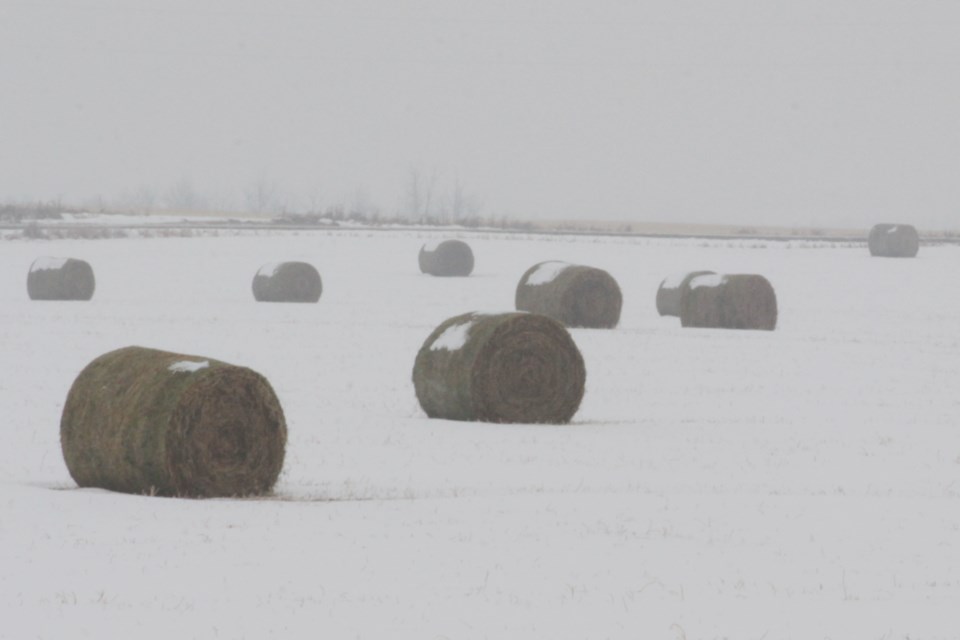Following an extremely challenging harvest and a decline in quality and reduced yields for most crops, the County of Barrhead has officially declared an agricultural disaster.
County of Barrhead councillors unanimously voted to declare the agricultural disaster during their Nov. 19 meeting. This was in line with the recommendation of the Barrhead Agricultural Service Board (ASB).
County manager Debbie Oyarzun said it was important to note that prior to making their recommendation, the ASB had reached out to local producers and agricultural companies for input. As well, they had also collected information from Alberta Agriculture and Forestry and the Agricultural Financial Services Corporation (AFSC).
“Some municipalities declare an agricultural disaster much earlier in the process and it’s more a show of good faith or support to producers than actually looking at data, whereas the (Barrhead) Ag Service Board actually went through the steps of reviewing the data and reviewing the information before making that decision,” she said.
The ASB report submitted to council stated that most sources agreed this was a below average year for the harvest of most crops, even taking into consideration the reduced acres.
Within the County of Barrhead, the AFSC estimated that canola yields were down 22 per cent, wheat yields were down 17 per cent, pea yields were down 33 per cent and barley was down 36 per cent.
While good quality wheat is normally produced within the county, the fall conditions had an adverse effect on wheat quality, the report stated. Hard red spring wheat dropped on average at last one grade over about 90 per cent of the crop, while much of Canadian Western Red Spring (CWRS) wheat may have dropped one to two grades.
As for canola, there appears to be very little sample canola available, which would drop the current price/bushel from $9.47 to $7.20.
Although very little malt barley is grown locally, significant premiums are paid for high bushel weight barley. However, Alberta Agriculture and Forestry was reporting that most barley would be very light this year, to the point of possibly requiring price discounts.
While the AFSC usually pegs malt acceptance from oats grown in the County of Barrhead at around 15 per cent, this year it would be closer to zero and the quality would drop a grade on average.
AFSC also estimated that peas would likely drop one grade on average, and while there might have been some faba beans harvested early that were fit for human consumption, most pulse crops would be rated as feed.
Reports on silage, hay and greenfeed production also indicated a reduction in acres harvested, yield and quality, with “unprecedented incidences” of producers having to bale hay in November.
Locally, just about every bushel harvested in the county would need to be dried, which would increase costs and, in some cases, limit marketing decisions. As well, there would be additional costs relating to equipment getting stuck, ruts being left in fields and other field management practices.
In summary, local producers were facing a triple threat to the economics of agricultural production, with a reduction in acres, yield and quality reported on all crops.
Coun. Walter Preugschas, who sits on the ASB, said that making the recommendation was a “difficult decision, for sure,” noting that while yields were far below average, it was still quite variable throughout the county.
“It does show support for the producers that were actually thinking of it,” he said. “Even though it may not give any financial support, at least we’re thinking about it.”
It should be that, according to the ASB’s report, the only automatic support the disaster declaration triggers is the CRA Drought-Induced Sale of Livestock provision, which protects revenue from forced sales of breeding herds until next year in the hopes of better conditions.
However, the declaration does indicate to agricultural lenders the difficulties faced by producers in 2019, and they may in turn provide struggling farmers with more lenient terms on their financial obligations.
Coun. Darrell Troock, who also sits on the ASB, pointed out that it’s not just an issue with grains and cereal crops, but with forage as well — there is no good hay available and there’s probably going to be shortages, he noted.
“It kind of left us no choice but to declare (an ag disaster) and do what we can do for farmers,” said Troock.
Fellow ASB member Coun. Marvin Schatz also pointed out that this is the fourth year of bad crops for local farmers, and that has an adverse effect on their mental health.
“Just thinking about them and showing support for them, I think, is a good step,” said Schatz.
Coun. Dennis Nanninga lauded the ASB for waiting until they had a clearer picture of how the local harvest would go before making a recommendation.
“That, to me, is a credible way of dealing with these disaster situations,” said Nanninga.
Reeve Doug Drozd said it would be important to put this information on the county’s website and communicate this information in other ways to their residents.
While some may question why the county waited so long to make the declaration, “we actually waited for some decent knowledge before we made that declaration,” he said.




